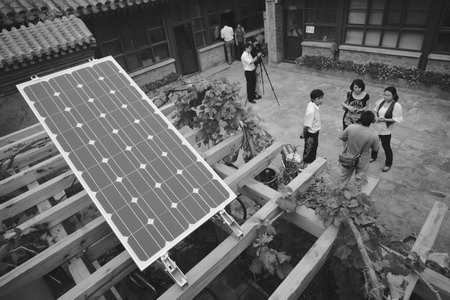Life and Leisure
Low carbon courtyard home turns heads in city
By Zhao Yanrong (China Daily)
Updated: 2010-10-08 08:19
 |
Large Medium Small |
|
 A Beijing real estate developer has turned this courtyard house in Dongcheng district into a ‘zero carbon’ building. Cui Meng/China Daily |
BEIJING - A real estate developer has renovated a courtyard house into a more environmentally friendly building as a model for Beijing's thousands of traditional houses to follow.
Developer Sino-Ocean Land recently rebuilt a Beijing courtyard house in the Dongcheng district into a "Zero-carbon" building. The 300-square-meter house has been used as offices for the Daxing Community Residents Committee for eight years.
As the signature architecture of Beijing, a typical courtyard house has a central open area surrounded by four buildings. Most are located in downtown Beijing.
Sino-Ocean Land's new design highlights two ways of saving energy: Cutting down the use of traditional energy and using more new energy, said Tu Zheng, designer of the "zero-carbon" house from Sino-Ocean.
Two 4-sq-m solar panels above the house's roof are able to power all lights and two fans in the living room. A vent high above the wall and ceiling grills allow air to flow, so dwellers don't need air conditioners to cope with a summer heat wave - a fan is at best all they need.
The walls of the main house are coated with insulation and windows are replaced by double glaze to maintain indoor temperature, particularly in winter. Four adjustable bamboo sheets shield windows from the heat of the summer sun.
LEDs light up the room, which save 90 percent of the electricity used by normal light bulbs.
All wood floors were certificated by the Forest Stewardship Council, proving the trees were grown and produced in a sustainable way.
A 4-sq-m water tank in the front yard collects rain and melted snow for watering plants in the courtyard.
"We are introducing the idea of using new energy and a low-carbon lifestyle, rather than selling the courtyard," Tu said.
However, the architect did not recommend using solar panels before the technique could be fully developed.
"The technique is not quite mature and the cost for a solar panel is still very expensive," Tu said. "Setting up a panel on the roof of a courtyard house harms the beauty of the whole architecture."
The architect expected smaller and more economical solar panels will be invented in three to five years.
During the past three months, which was also the first summer aer the reconstruction, the cost of electricity was about 68 percent less than the previous year. Tu predicted the new courtyard will save more than 5,300 yuan ($790) on electricity bills every year.
However, updating a courtyard house into such a "green" house costs at least 200,000 yuan, said Duan Tao, project manager from Sino- Ocean Land.
"The whole world is experiencing climate change and we have learned how bad it could be through the Copenhagen summit, and thus the 'green' community is the future," Duan said.
Duan hopes to attract more Beijing residents to the lowcarbon lifestyle by upgrading the city's housing.
On the other hand, local residents are not yet quite accepting the new design. A local resident surnamed Zhang, who works in the model courtyard every day, said some of the designs are not practical.
"Most courtyard houses are full of people and we do not need a water tank to water the flowers since there won't be space for any plants in our yards," Zhang said.
"I actually didn't feel the house cooler than it was before the reconstruction." He also said he won't resort to solar panels because they cost too much but provide little power. "Living green means that you have to pay more money, which most working families cannot afford," Zhang said.
Duan agreed that it costs time and money to change people's lifestyles.